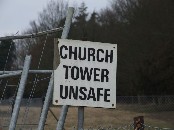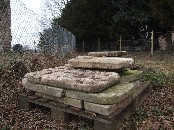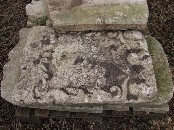| |
|
 |
|
The ruined church of St
Genevieve, marooned in the park of Fornham Hall
to the north of Bury, holds a special place in
the story of this website. Suffolk has about five
hundred surviving medieval churches, and the
ruins of a dozen more, and the known sites of a
further twenty or so. And out of all of these,
this was the very last one that I visited. The tower, which is all that
survives, stands on private land, a good half a
mile from the nearest road, and for a long time
it was was pretty well inaccessible. I knew
people who had been to it, and I had seen their
photographs, but I had received far more e-mails
from people wondering how on earth to get to it.
|
Although the
church is only a mile or so north of Bury St Edmunds, it
stands on wild heathland, and is not reachable from the
village of Fornham St Genevieve itself. Instead, you have
to approach it from the north, along a track which begins
on a back road near Culford. In the old days, this would
have meant risking the wrath of the owners of Fornham
Hall, but today the Hall stands empty, and is being
converted into apartments.
The church
was destroyed by fire in 1775, an accident occasioned
by a man shooting at some jackdaws on the steeple
according to the Ipswich Journal reported in the 2015
revision of the Pevsner volume for West Suffolk. It was
derelicted soon after, by which time the parish had been
made a joint one with Fornham All Saints. In later years,
it stood service as a water tower for the Hall. The tower
is interesting from an ecclesiological point of view,
because of course it never underwent a Victorian
restoration, and is probably what many East Anglian
towers looked like before their bell windows were renewed
by well-meaning 19th century architects.
By the 1980s,
the site had become rather overgrown, but has been
cleared in recent months, and a pile of rescued 18th
century gravestones lies on pallets beside the site. It
would be nice to think that they might be reset in an
appropriate manner.
The tower is
surrounded by safety fencing, with a warning notice. But
many East Anglian ruins have been made safe for public
enjoyment in recent years, largely due to the energy of
Norfolk County Council. They have no jurisdiction here of
course, but it would be nice to think that their example
might be followed.
Simon
Knott, 2008


Amazon commission helps cover the running
costs of this site
|
|
|

